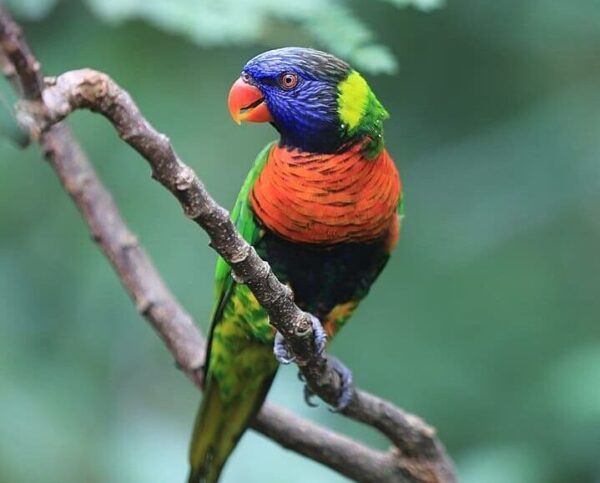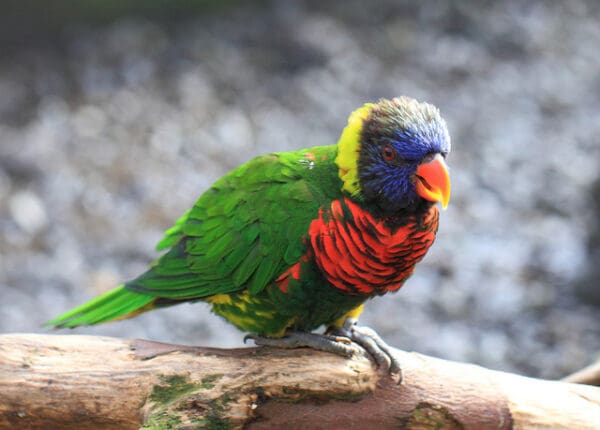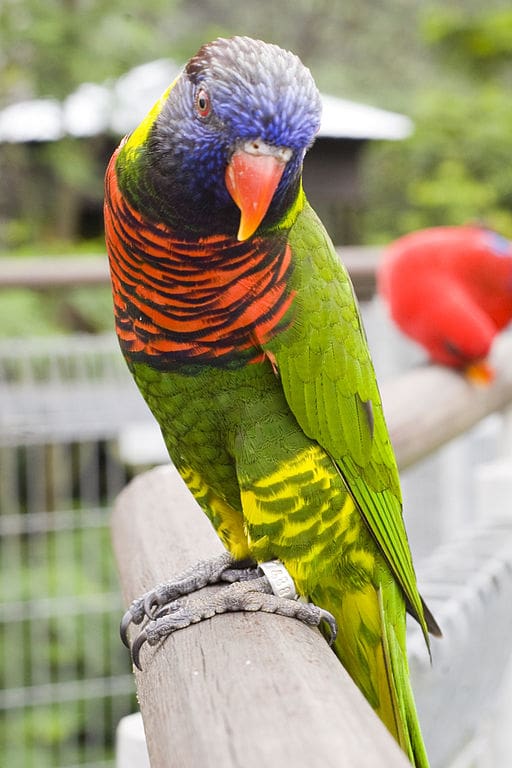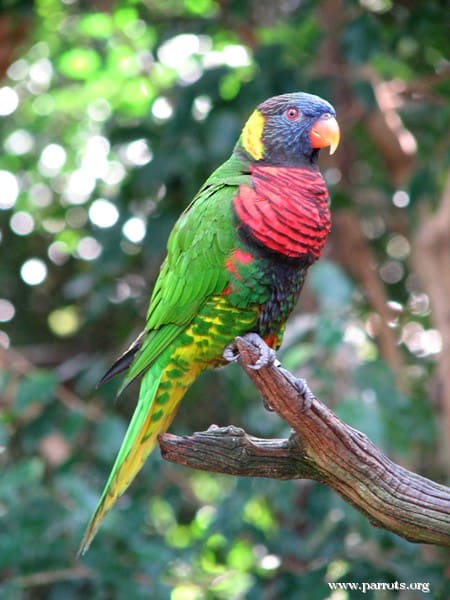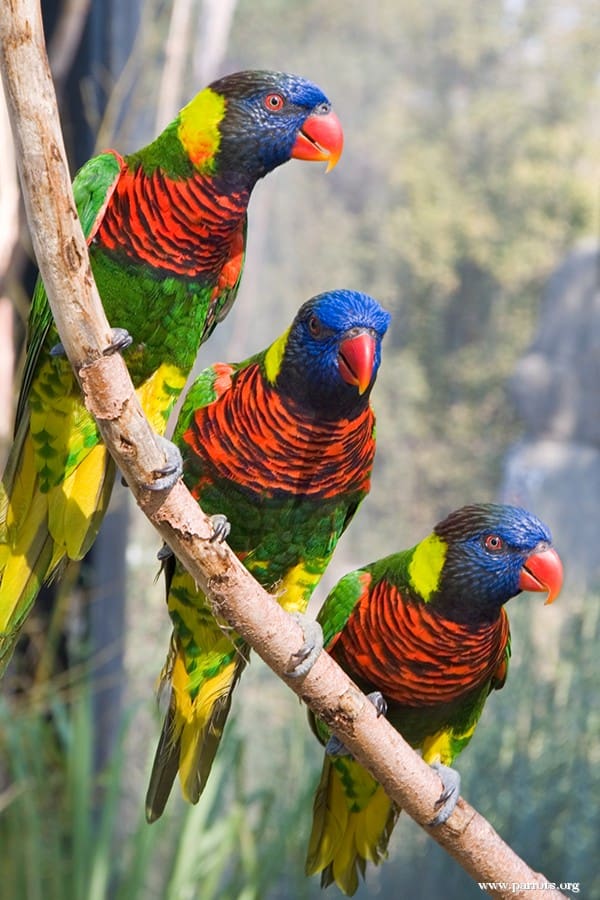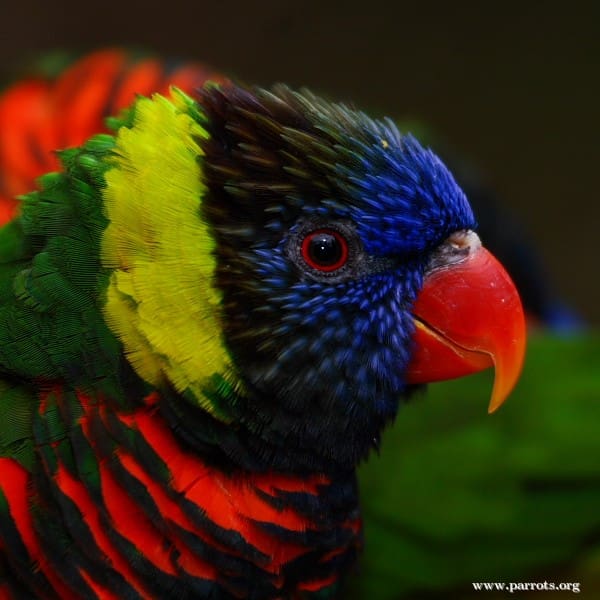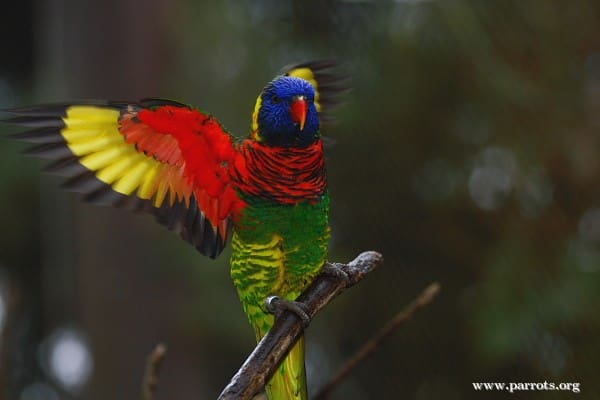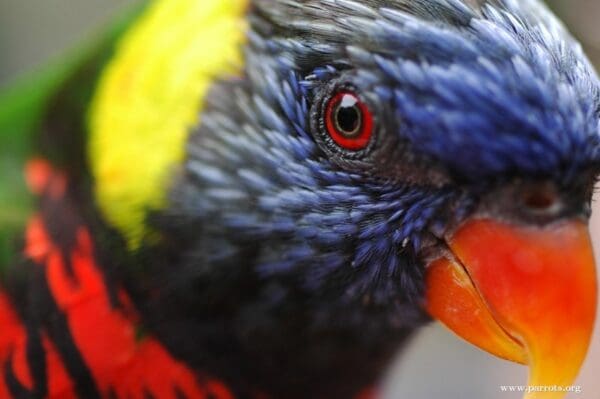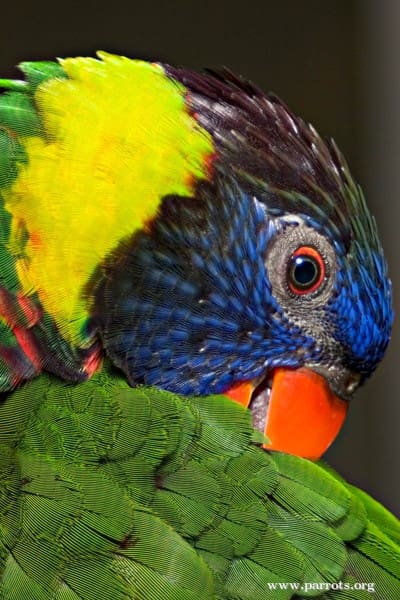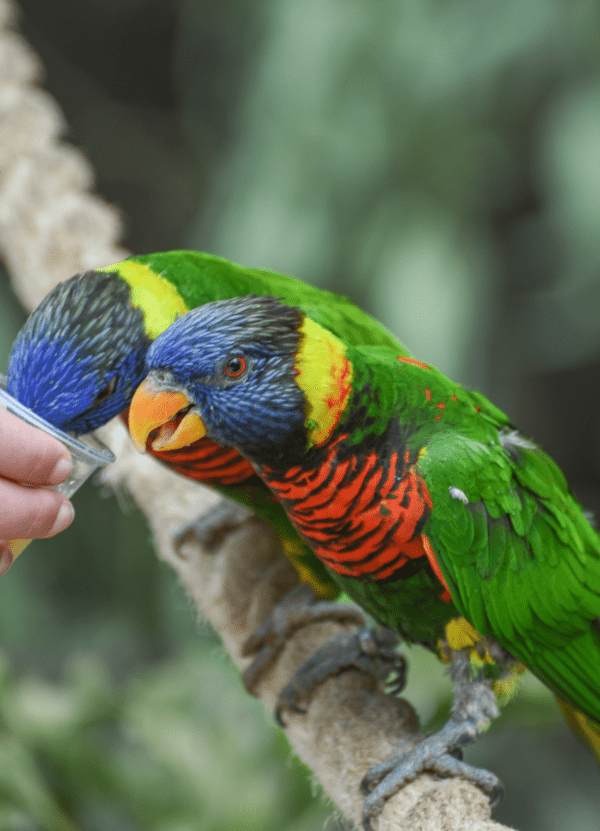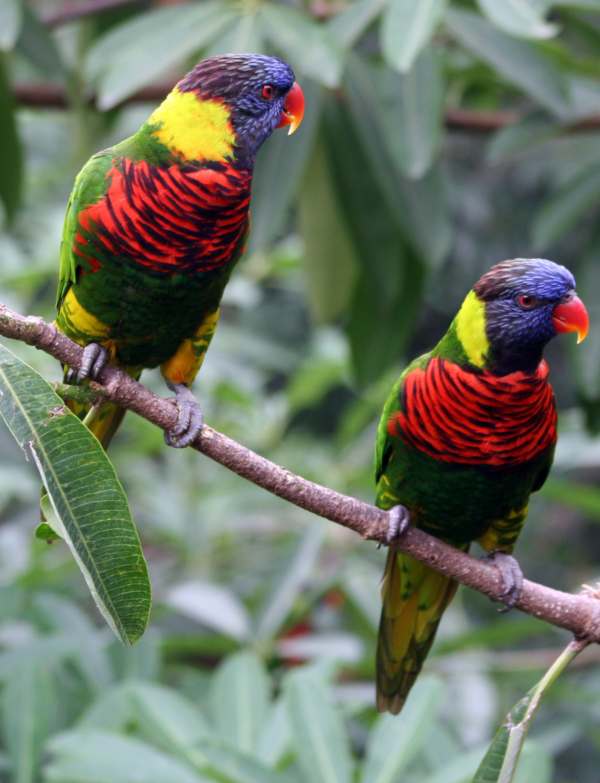Coconut Lorikeet
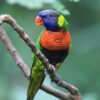
![© Tanaka Juuyoh [CC BY-SA 2.0] via Flickr A Coconut Lorikeet perches on a branch](https://gt2024.parrots.org/wp-content/uploads/2023/01/wpt_Coconut-Lorikeet_1134-21-100x100.jpg)
![© Zhao [CC BY 2.0] via Wikimedia Commons A Coconut Lorikeet perches on a railing at Jurong Bird Park](https://gt2024.parrots.org/wp-content/uploads/2023/01/wpt_Coconut-Lorikeet_1134-14-100x100.jpg)
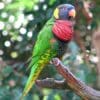
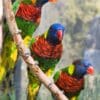
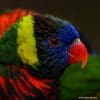
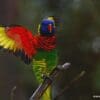
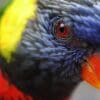
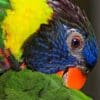
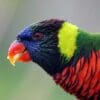
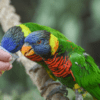
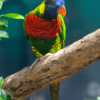
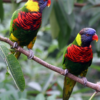
DID YOU KNOW?
The Coconut Lorikeet, although common, is suspected to be in decline due to unsustainable levels of trapping.

Trichoglossus

haematodus
Size:
26 cm (10 in)
Weight:
100-157 g (3.5-5.5 oz)
Subspecies including nominate:
nine: T.h. haematodus, T.h. nigrogularis, T.h. intermedius, T.h. micropteryx, T.h. caeruleiceps, T.h. flavicans, T.h. nesophilus, T.h. massena, T.h. deplanchii
Colour Adult:
T.h. haematodus: Both adults brown/black head with lilac/blue streaks on face; collar yellow/green; red breast banded with blue/black; dark green abdomen; green/yellow thighs to undertail coverts; green upperparts and tail; orange underwing coverts; yellow, wide band under the wing. Beak orange/red. Eye dark orange.
T.h. micropteryx: Both adults differ from haematodus by paler body colour; banding on breast narrower; collar greener.
T.h. caeruleiceps: Both adults strong lilac/blue streaking on entire crown and sides of head; orange/red breast, thinly barred with blue/black; blue/black upper abdomen; lower abdomen orange/red with more evident blue/black barring.
T.h. nigrogularis: Both adults as in caeruleiceps but larger, with blue streaks on head much darker.
T.h. massena: Both adults as in micropteryx, but have strong brown wash on occiput and nape; collar less yellowish; paler red breast with fine bars of blue/black.
T.h. flavicans: Both adults have varying plumage with bronze/yellow to dull green upperparts and undertail coverts; collar yellow; red/brown occiput; purple/blue streaked forehead, lores and area around eyes, remainder of head black, with grey/green streaking; bright red breast with minimal barring.
T.h. nesophilus: Both adults as in flavicans but with green upper body, undertail coverts and tail which never vary to bronze/yellow.
T.h. deplanchii: Both adults as in massena but with more blue streaking on head, occiput and nape less brown, and less yellow on thighs to undertail coverts; blue/black markings vary on upper abdomen.
Colour Juvenile:
T.h. haematodus: Duller than adult. Beak brown/black. Cere and eye ring grey/white, eye brown.
T.h. micropteryx: As in adults.
T.h. caeruleiceps: As in adults.
T.h. nigrogularis: As in adults.
T.h. massena: As in adults.
T.h. flavicans: As in adults.
T.h. nesophilus: As in adults.
T.h. deplanchii: As in adults.
Call:
Repeated notes, sharp, rolling while in flight. Shrill chattering while feeding. Soft notes at rest.
More Information:
Content Sources:
CITES
BirdLife International
Cornell Lab of Ornithology/Birds of the World
Parrots: A Guide to Parrots of the World, Juniper and Parr, 1998
Parrots of the World, Forshaw and Cooper, 1989. 2010 edition
Rainbow Lorikeets, Mike Owen
Rainbow Lories in American Aviculture, Margarethe Warden
Parrots of the World, Forshaw, 2006.
Parrots in Aviculture, Low, 1992.
UNEP-WCMC CITES Trade Database, January 2005.
Captive Status:
Common
Longevity:
20 yrs in the wild. 15-25 yrs in captivity.
Housing:
Enclosure with drain in floor, or suspended cage over tiled or concrete floor.
Diet:
Nectar – a commercial type specially formulated for small species or a mix of baby cereal (lactose-free) and honey, malt extract or molasses, mixed with filtered water, made fresh once or twice daily, making up at least 40 percent of the diet; vegetables and fruit especially apple, pear, orange, cactus fruits and bananas, and one or more daily of: carrot, fresh corn, green leaves; plus dried figs soaked in water for a few hours, spray millet and a small amount of soaked or sprouted sunflower seed and small amount of canary seed.
Enrichment:
Loves bathing, hanging toys, puzzle/foraging toys, foot toys, ladders, swings, socializing; noisy toys (bells, squeakers), bird safe chewables (vegetable tanned leather, safe woods).
Nest Box Size:
L-shaped box, 51 cm x 36 cm (20 x 14 in).
Clutch Size:
2 to 3
Fledging Age:
8-9 weeks
Hatch Weight:
—
Peak Weight:
—
Weaning Weight:
—
World Population:
Unknown; described as common to abundant. Decreasing.
IUCN Red List Status:
Least Concern
CITES Listing:
Appendix II
Threat Summary:
Not globally threatened. Is affected by heavy trapping for trade. Ambon population now very small, and the species is uncommon on Kai Island. No recent records on Kisar, where it likely was not naturally common. Abundant throughout much of New Guinea and common on Karkar, New Georgia and New Britain, especially in the lowlands and foothills. Small numbers but widespread on Bougainville, abundant in N Solomons. Fairly common on New Caledonia, where psittacine beak and feather disease has been identified in the population.
Range:
T.h. haematodus: Found in Tayandu, Kai Islands, west through Watubela and Seramlaut Islands to Seram, Ambon, and Buru, South Moluccas, and W Papuan Islands to islands in Geelvink Bay, excluding Biak, and W New Guinea, east to Astrolabe Bay, Papua New Guinea and in south to upper Fly River, W Papua New Guinea; Manam and possibly Schouten Islands, N Papua New Guinea.
T.h. micropteryx: Found E Papua New Guinea, west to Huon Peninsula in north to central ranges around Lake Kutubu and to Hall Sound in south; also Misima Island in Louisiade Archipelago.
T.h. caeruleiceps: Found S New Guinea between lower Fly River, SW Papua New Guinea and Princess Marianne Straits, SE Irian Jaya; also Boigu and Saibai Islands, northern Torres Strait, Queensland, Australia.
T.h. nigrogularis: Occurs on Aru Islands and E Kai Islands, Indonesia.
T.h. massena: Found on Karkar Island and Bismarck Archipelago, E Papua New Guinea, east through Bougainville and Solomon Islands to Vanuatu.
T.h. flavicans: Occurs in New Hanover, Admiralty Islands and Nuguria Islands, E Papua New Guinea.
T.h. nesophilus: Found in Hermit and Ninigo Islands, N Papua New Guinea.
T.h. deplanchii: Found on New Caledonia and Loyalty Islands.
Habitat:
Most common in lowlands but found up to 2400 m (7872 ft). Wide variety of areas including settlements, forest, coconut plantations, savanna, Eucalypt stands and mangroves.
Wild Diet:
Feeds mainly on nectar but also takes figs, insects and can be found around man-made feeding stations. Seen feeding on Casuanna and flowers of Melicope.
Ecology and Behaviour:
Found in mixed flocks with other parrots; in small noisy groups. Nomadic, as they are dependent on flowering trees. Roosts communally in groups of hundreds of birds. Will also roost and nest on the ground on some of the predator-free islands. Displays frequently.
Clutch and Egg Size:
2 to 3 ovate eggs, 27.0 x 22.5 mm (1 x 0.9 in).
Breeding Season:
Breeding recorded most months in New Guinea; November–December, Buru; August–January,Vanuatu; September–February, New Caledonia; Solomon Islands, August. Nest is in tree cavity.
Related Links:
—
